Be动词和助动词的用法区别
be动词、助动词、情态动词用法课件(35张)

情态动词的用法
1
表示能力
情态动词can和could用于表示能力或可能性。
2
表示意愿
情态动词may、might和would用于表达意愿、请求或建议。
3
表示推测
情态动词must、should和will用于推测、假设和推理。
例句解析
be动词
He is a doctor.
助动词
She can sing beautifully.
情态动词
You should study harder.
情态动词
情态动词用于表达说话人的态度、推测、建议 等具有情感色彩的意义。
一般助动词
一般助动词可以帮助构成英语的各种时态、语 态ቤተ መጻሕፍቲ ባይዱ情态,并提供附加的信息。
情态动词介绍
1 常见情态动词
了解常见的情态动词,如can、could、may等。
2 情态动词的用法
掌握情态动词在不同语境下的用法,如表达能力、可能性、建议等。
be动词、助动词、情态动 词用法课件(PPT35张)
本课件将详细介绍be动词、助动词和情态动词的用法。带你从基础到进阶, 掌握这些动词的使用技巧,使你的英文表达更加准确、流利。
be动词介绍
1 基础知识点
2 语言实践
掌握be动词的基本形式、变化规则及其在 句子中的作用。
通过实例运用,感受be动词在不同语境下 的使用。
be动词的用法
表示存在
使用be动词描述人、事、物的存在状态。
表示身份
使用be动词表达个体的身份、职业等信息。
表示状态
使用be动词描述人、事、物的临时或持续状态。
助动词介绍
1 助动词定义
了解助动词的特点和作用,掌握其常见的几种。
人教版七年级上册英语语法知识——助动词do和be动词的用法及区别(无答案)
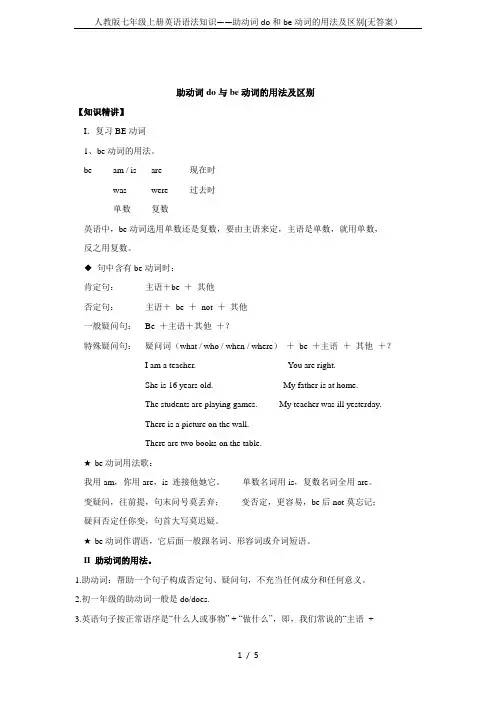
人教版七年级上册英语语法知识——助动词do和be动词的用法及区别(无答案)助动词do与be动词的用法及区别【知识精讲】I.复习BE动词1、be动词的用法。
be am / is are 现在时was were 过去时单数复数英语中,be动词选用单数还是复数,要由主语来定,主语是单数,就用单数,反之用复数。
◆句中含有be动词时:肯定句:主语+be +其他否定句:主语+be +not +其他一般疑问句:Be +主语+其他+?特殊疑问句:疑问词(what / who / when / where)+be +主语+其他+?I am a teacher. You are right.She is 16 years old. My father is at home.The students are playing games. My teacher was ill yesterday.There is a picture on the wall.There are two books on the table.★ be动词用法歌:我用am,你用are,is 连接他她它。
单数名词用is,复数名词全用are。
变疑问,往前提,句末问号莫丢弃;变否定,更容易,be后not莫忘记;疑问否定任你变,句首大写莫迟疑。
★ be动词作谓语,它后面一般跟名词、形容词或介词短语。
II 助动词的用法。
1.助动词:帮助一个句子构成否定句、疑问句,不充当任何成分和任何意义。
2.初一年级的助动词一般是do/does.3.英语句子按正常语序是“什么人或事物” + “做什么”,即,我们常说的“主语+谓语+ 其他”。
但要进行句型转换时,句中谓语为行为动词,就要借助助动词do/does.①主语为I 或复数名词、代词时:肯定句:I / We / They / The students +动词原形+其他+。
We watch TV every night.变否定:主语+don’t +动词原形+其他+。
be动词、助动词、情态动词讲解(基础篇)第一讲
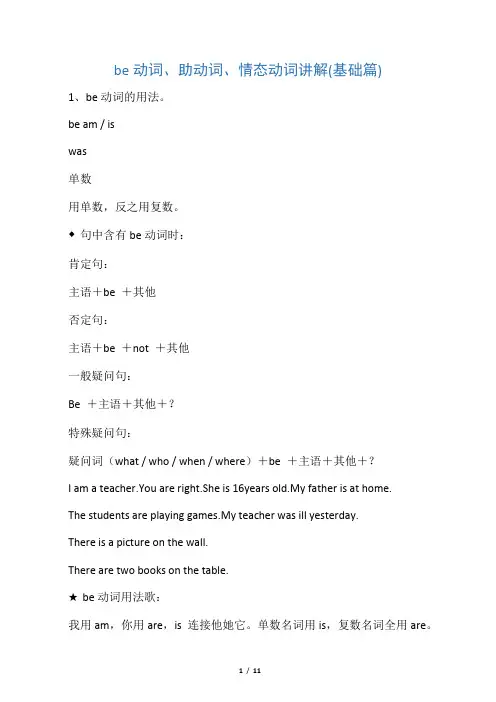
D. are, like
2. A:
How many days __ there in a week?
B:
There __ seven.
A. is, is
B. are, are
C. is, are
D. are, is
3. The boy __ ill today.
A. are
be
1、be动词的用法。
be am / is
was
单数
用单数,反之用复数。
◆句中含有be动词时:
肯定句:
主语+be+其他
否定句:
主语+be+not+其他
一般疑问句:
Be+主语+其他+?
特殊疑问句:
疑问词(what / who / when / where)+be+主语+其他+?
I am a teacher.You are right.She is 16years old.My father is at home.
B. is
C. be
D. am
4. What ___ your father ___?
A. do, like
B. is, like
C. are, likes
D. does, like
5. ___ you go to school by bus?
A. Are
B. Is
C. Do
D. Does
6. When ___ your birthday?
否定句:
主语+ didn’t +动词原形+其他+。
He / We didn’t get up early every morning last year.一般疑问句:
Be动词的形式和用法
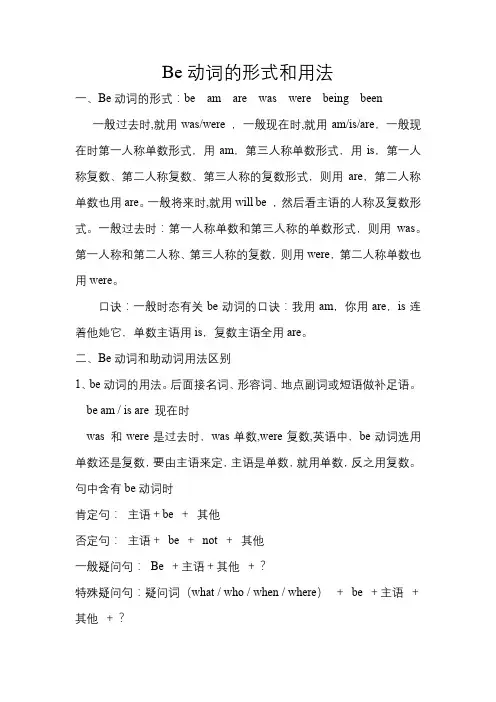
Be动词的形式和用法一、Be动词的形式:be am are was were being been一般过去时,就用was/were ,一般现在时,就用am/is/are,一般现在时第一人称单数形式,用am,第三人称单数形式,用is,第一人称复数、第二人称复数、第三人称的复数形式,则用are,第二人称单数也用are。
一般将来时,就用will be ,然后看主语的人称及复数形式。
一般过去时:第一人称单数和第三人称的单数形式,则用was。
第一人称和第二人称、第三人称的复数,则用were,第二人称单数也用were。
口诀:一般时态有关be动词的口诀:我用am,你用are,is连着他她它,单数主语用is,复数主语全用are。
二、Be动词和助动词用法区别1、be动词的用法。
后面接名词、形容词、地点副词或短语做补足语。
be am / is are 现在时was 和were是过去时,was单数,were复数,英语中,be动词选用单数还是复数,要由主语来定,主语是单数,就用单数,反之用复数。
句中含有be动词时肯定句:主语+be +其他否定句:主语+be +not +其他一般疑问句:Be +主语+其他+?特殊疑问句:疑问词(what / who / when / where)+be +主语+其他+?如:I am a teacher.You are right.She is 16 years old.My father is at home.The students are playing games.My teacher was ill yesterday.There is a picture on the wall.There are two books on the table.be动词用法歌:我用am,你用are,is 连接他她它。
单数名词用is,复数名词全用are。
变疑问,往前提,句末问号莫丢弃;变否定,更容易,be后not莫忘记;疑问否定任你变,句首大写莫迟疑。
助动词do doesdid 和be动词am is are用法的区别
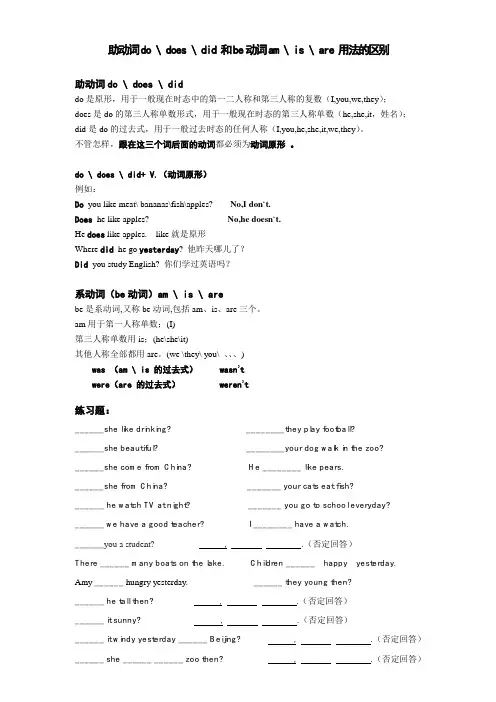
助动词do \ does \ did 和be动词am \ is \ are 用法的区别助动词do \ does \ diddo是原形,用于一般现在时态中的第一二人称和第三人称的复数(I,you,we,they);does是do的第三人称单数形式,用于一般现在时态的第三人称单数(he,she,it,姓名);did是do的过去式,用于一般过去时态的任何人称(I,you,he,she,it,we,they)。
不管怎样,跟在这三个词后面的动词都必须为动词原形。
do \ does \ did+ V.(动词原形)例如:Do you like meat\ bananas\fish\apples? No,I don`t.Does he like apples? No,he doesn`t.He does like apples. like就是原形Where did he go yesterday? 他昨天哪儿了?Did you study English? 你们学过英语吗?系动词(be动词)am \ is \ arebe是系动词,又称be动词,包括am、is、are三个。
am用于第一人称单数;(I)第三人称单数用is;(he\she\it)其他人称全部都用are。
(we \they\ you\ 、、、)was (am \ is 的过去式) wasn’twere(are 的过去式) weren’t练习题:______she like drinking? ________they play football?______she beautiful? ________your dog walk in the zoo?______she come from China? He ________ like pears.______she from China? _______ your cats eat fish?______ he watch TV at night? _______ you go to school everyday?______ we have a good teacher? I ________ have a watch.______you a student? , .(否定回答)There ______ many boats on the lake. Children ______ happy yesterday.Amy ______ hungry yesterday. ______ they young then?______ he tall then? , .(否定回答)______ it sunny? , .(否定回答)______ it windy yesterday ______ Beijing? , .(否定回答)______ she ______ ______ zoo then? , .(否定回答)。
be动词、助动词、情态动词讲解第一讲
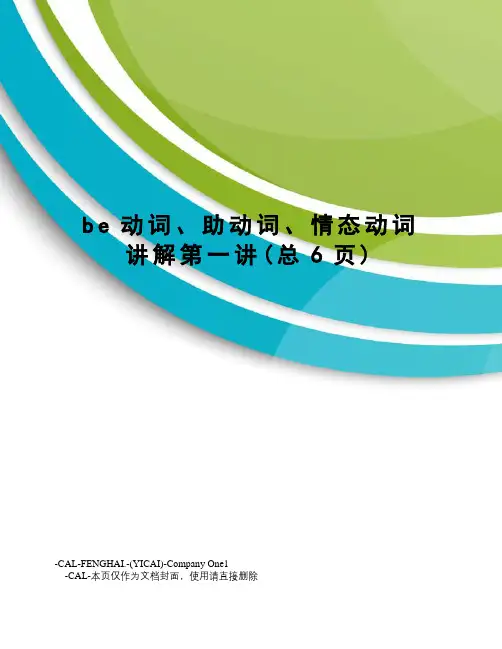
b e动词、助动词、情态动词讲解第一讲(总6页)-CAL-FENGHAI.-(YICAI)-Company One1-CAL-本页仅作为文档封面,使用请直接删除be动词、助动词、情态动词讲解 (基础篇)1、be动词的用法。
英语中,be动词选用单数还是复数,要由主语来定,主语是单数,就用单数,反之用复数。
◆ 句中含有be动词时:肯定句:主语+be +其他否定句:主语+ be + not +其他一般疑问句: Be +主语+其他+特殊疑问句:疑问词(what / who / when / where)+ be +主语+其他+?I am a teacher. You are right.She is 16 years old. My father is at home.The students are playing games. My teacher was ill yesterday.There is a picture on the wall.There are two books on the table.★ be动词用法歌:我用am,你用are,is 连接他她它。
单数名词用is,复数名词全用are。
变疑问,往前提,句末问号莫丢弃;变否定,更容易,be后not 莫忘记;疑问否定任你变,句首大写莫迟疑。
★ be动词作谓语,它后面一般跟名词、形容词或介词短语。
她个子很高。
她在教室里。
她是一个高个子的女孩。
2、助动词的用法。
英语句子按正常语序是“什么人或事物” + “做什么”,即,我们常说的“主语 + 谓语 + 其他”。
① 主语为I 或复数名词、代词时:肯定句: I / We / They / The students +动词原形+其他+。
We watch TV every night.变否定:主语+don’t +动词原形+其他+。
We don’t watch TV every night.一般疑问句 Do + 主语 + 动词原形 + 其他 +Do you watch TV every night?Yes, we do. / No, we don’t.特殊疑问句:疑问词 + do + 主语 + 动词原形 + 其他 +How often do you watch TV?② 主语为单数名词或代词时:肯定句:主语 + 动词第三人称单数形式 + 其他 + 。
助动词dodoesdid和be动词amisare用法的区别
助动词do \ does \ did 和be动词am \ is \ are 用法的区别助动词do \ does \ diddo是原形,用于一般现在时态中的第一二人称和第三人称的复数(I,you,we,they);does是do的第三人称单数形式,用于一般现在时态的第三人称单数(he,she,it,姓名);did是do的过去式,用于一般过去时态的任何人称(I,you,he,she,it,we,they)。
不管怎样,跟在这三个词后面的动词都必须为动词原形。
do \ does \ did+ V.(动词原形)例如:Do you like meat\ bananas\fish\apples? No,I don`t.Does he like apples? No,he doesn`t.He does like apples. like就是原形Where did he go yesterday? 他昨天哪儿了?Did you study English? 你们学过英语吗?系动词(be动词)am \ is \ arebe是系动词,又称be动词,包括am、is、are三个。
am用于第一人称单数;(I)第三人称单数用is;(he\she\it)其他人称全部都用are。
(we \they\ you\ 、、、)was (am \ is 的过去式)wasn’twere(are 的过去式)weren’t练习题:______she like drinking? ________they play football?______she beautiful? ________your dog walk in the zoo?______she come from China? He ________ like pears.______she from China? _______ your cats eat fish?______ he watch TV at night? _______ you go to school everyday?______ we have a good teacher? I ________ have a watch.______you a student? , .(否定回答)There ______ many boats on the lake. Children ______ happy yesterday.Amy ______ hungry yesterday. ______ they young then?______ he tall then? , .(否定回答)______ it sunny? , .(否定回答)______ it windy yesterday ______ Beijing? , .(否定回答)______ she ______ ______ zoo then? , .(否定回答)1 / 1。
be动词,助动词,冠词用法
be动词、助动词、冠词用法Be动词用法歌I用am, you用are;Is 连着he(他), she(她), it 它;单数名词用is ,复数名词全用are助动词be的用法:1)be +现在分词,构成进行时态,例如:They are having a meeting.他们正在开会。
English is becoming more and more important. 英语现在越来越重要。
2)be + 过去分词,构成被动语态,例如:The window was broken by Tom..窗户是汤姆打碎的。
English is taught throughout the world.世界各地都教英语。
3)be + 动词不定式,可表示下列内容:a. 表示最近、未来的计划或安排,例如:He is to go to New York next week..他下周要去纽约。
We are to teach the freshpersons.我们要教新生。
说明:这种用法也可以说成是一种将来时态表达法。
b. 表示命令,例如:You are to explain this.对此你要做出解释。
He is to come to the office this afternoon.要他今天下午来办公室。
c.征求意见,例如:How am I to answer him?我该怎样答复他?Who is to go there?谁该去那儿呢?d. 表示相约、商定,例如:We are to meet at the school gate at seven tomorrow morning.我们明天早晨7点在校门口集合。
助动词DO的用法1.DO包括do,does,did三种形式,主要用于特殊的句型中。
Do you know him? 你认识他吗?(用于一般疑问句。
)He didn't come to school today. 他今天没上学。
Be动词和助动词的用法区别
Be动词和助动词的用法区别1、be动词的用法。
be am / is are 现在时was were 过去时单数复数英语中,be动词选用单数还是复数,要由主语来定,主语是单数,就用单数,反之用复数。
◆句中含有be动词时:肯定句:主语+be +其他否定句:主语+be +not +其他一般疑问句:Be +主语+其他+?特殊疑问句:疑问词(what / who / when / where)+be +主语+其他+?I am a teacher. You are right.She is 16 years old. My father is at home.The students are playing games. My teacher was ill yesterday.There is a picture on the wall.There are two books on the table.★ be动词用法歌:我用am,你用are,is 连接他她它。
单数名词用is,复数名词全用are。
变疑问,往前提,句末问号莫丢弃;变否定,更容易,be后not莫忘记;疑问否定任你变,句首大写莫迟疑。
★ be动词作谓语,它后面一般跟名词、形容词或介词短语。
2、助动词的用法。
英语句子按正常语序是“什么人或事物” + “做什么”,即,我们常说的“主语+ 谓语+ 其他”。
①主语为I 或复数名词、代词时:肯定句:I / We / They / The students +动词原形+其他+。
We watch TV every night.变否定:主语+don’t +动词原形+其他+。
We don’t watch TV every night.一般疑问句Do + 主语+ 动词原形+ 其他+ ?Do you watch TV every night?Yes, we do. / No, we don’t.特殊疑问句:疑问词+ do + 主语+ 动词原形+ 其他+ ?How often do you watch TV?②主语为单数名词或代词时:肯定句:主语+ 动词第三人称单数形式+ 其他+ 。
动词种类及用法总结
动词一.动词:表示动作或状态。
二.种类:1.be 动词: is, am, are, was, were2.助动词:⑴ be 动词:用于现在 / 过去进行时,被动语态⑵ do, does, did 用于构成一般现在时 / 一般过去时⑶ has, have, had 用于构成现在完成时/ 过去完成时⑷Will ,shall, would , should, be going to三.行为 / 实义动词1. 及物动词:直接加人或事物作宾语的动词。
give, tell , teach, ask, eat不及物动词:不能直接加人或事物作宾语的动词,若加宾语,借介词或副词。
Look at/after/up/into/for , take away, put on/away/off , try on.2.延续性动词: run, cry, teach,study,learn.非延续性动词 / :buy,lend,finish,leave,close,open,join,borrow.3.情态动词:有实义,不能单独作谓语,与实义动词一起作谓语。
Can, may,must,might,could,need,have to, dare,be able to, will,shall,should,would,had better,ought to,be supposed to. 只加动原4.连系动词:有实义,不能单独作谓语,与名词,形容词,动词不定式,现在分词,动名词,介词短语一起构成系表结构,说明主语的状况,性质,特征。
口诀:一是(be),一觉( feel),一好像(seem)。
四个起来( look 看起来, sound 听起来, smell 闻起来, taste 尝起来)四个变得( get,become ,turn , go)Seem 的用法:主 +seems/seemed+adj.主+seems/seemed+to do sth.It+seems/seemed+that从句Eg.He seems a little unhappy.= He seems to be a little unhappy=It seems that he is a liitle unhappy.种类:状态系动词:be持续系动词:keep,remain , stay表象系动词:seem, appear, look感官系动词: feel , smell ,sound ,taste变化系动词: become , get, turn , go, grow5.感官动词:一感( feel),二听( listen to ,hear),四看( look at ,see,watch , notice )使役动词:三使(let ,make, have) +sb.+do sth.Get sb.+to do sth.四.接双宾语的及物动词:1.主 +及物动词 +间接宾语(人)+直接宾语(事物)=主 +vt.+st.+to sb.award , bring, hand ,lend , mail, offer , pass, post, return ,send, sell,serve,show, teach, tell , write , give,kick2.主 +及物动词 +间接宾语(人)+直接宾语(事物)=主 +vt.+st.+for sb.book, buy, choose, cook, make, draw , fix,order ,fetch, pick,prepare ,sing,steal五.非谓语短语:不能作谓语,只能做宾语,主语,定语,状语,宾语补足语,表语。
- 1、下载文档前请自行甄别文档内容的完整性,平台不提供额外的编辑、内容补充、找答案等附加服务。
- 2、"仅部分预览"的文档,不可在线预览部分如存在完整性等问题,可反馈申请退款(可完整预览的文档不适用该条件!)。
- 3、如文档侵犯您的权益,请联系客服反馈,我们会尽快为您处理(人工客服工作时间:9:00-18:30)。
1、be动词的用法。
be am / is are 现在时
was were 过去时
单数复数
英语中,be动词选用单数还是复数,要由主语来定,主语是单数,就用单数,反之用复数。
◆句中含有be动词时:
肯定句:主语+be +其他
否定句:主语+ be + not +其他
一般疑问句: Be +主语+其他+?
特殊疑问句:疑问词(what / who / when / where)+ be +主语+其他+?
I am a teacher. You are right.
She is 16 years old. My father is at home.
The students are playing games. My teacher was ill yesterday.
There is a picture on the wall.
There are two books on the table.
★ be动词用法歌:
我用am,你用are,is 连接他她它。
单数名词用is,复数名词全用are。
变疑问,往前提,句末问号莫丢弃;变否定,更容易,be后not莫忘记;
疑问否定任你变,句首大写莫迟疑。
★ be动词作谓语,它后面一般跟名词、形容词或介词短语。
2、助动词的用法。
英语句子按正常语序是“什么人或事物” + “做什么”,即,我们常说的“主语 + 谓语 + 其他”。
①主语为I 或复数名词、代词时:
肯定句: I / We / They / The students +动词原形+其他+。
We watch TV every night.
变否定:主语+don’t +动词原形+其他+。
We don’t watch TV every night.
一般疑问句 Do + 主语 + 动词原形 + 其他 + ?
Do you watch TV every night?
Yes, we do. / No, we don’t.
特殊疑问句:疑问词 + do + 主语 + 动词原形 + 其他 + ?
How often do you watch TV?
②主语为单数名词或代词时:
肯定句:主语 + 动词第三人称单数形式 + 其他 + 。
He watches TV every night.
否定句:主语+ doesn’t+动词原形+其他+。
He doesn’t watch TV every night.
一般疑问句:Does + 主语 + 动词原形 + 其他 + ?
Does he watch TV every night?
Yes, he does. / No, he doesn’t.
特殊疑问句:疑问词 + does + 主语 + 动词原形 + 其他 + ?
How often does he watch TV?
③过去时的句式(当句子时态为过去时时,动词用过去式,不受主语单复数的影响)肯定句:主语 + 过去式 + 其他 + 。
He / We got up early every morning last year.
否定句:主语+ didn’t + 动词原形 + 其他 + 。
He / We didn’t get up early e very morning last year.
一般疑问句: Did + 主语 + 动词原形 + 其他 + ?
Did he / you get up early every morning last year?
Yes, he / we did. / No, he / we didn’t.
特殊疑问句:疑问词 + did + 主语 + 动词原形 + 其他 + ?
When did he / you get up every morning last year?。
